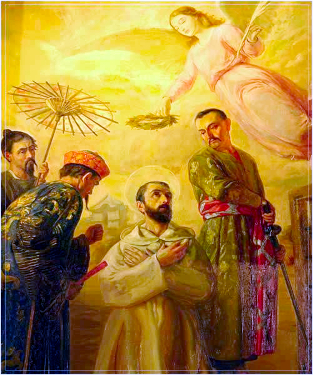Lives of the Saints
Our Models and Protectors
Spiritual Bouquet:
November 7

Saint Hyacinth Castañeda
Dominican Priest and Missionary,
Martyred in Vietnam
(1743-1773)
Son of notary José Castañeda and María Puchsons, Jacinto (Hyacinth) was born in Játiva, in the diocese of Valencia, on January 13, 1743, and was baptized the same day. His pious parents gave him a solid Christian education. From his childhood he was attracted to the life of the Dominican friars and on December 3, 1756, he entered the convent of Saint Dominic in his native city. On January 11, 1759, he took his religious vows. From the beginning of his religious life, he distinguished himself by his application to study and his determination to be faithful to the regular observance in every detail.
In May 1761, a circular was read in the community asking for missionaries for the Far East. Several religious gave their names, including Jacinto Castañeda. On November 20, 1762, they embarked for Mexico, where they arrived on February 23 of the following year, and went to Acapulco to take the ship to their destination. Finally, on October 28, 1763, they arrived exhausted in Manila, after countless labors and hardships, having escaped various shipwrecks, illnesses and plagues, having lost two religious, and fleeing from English privateers through muddy and inhospitable terrain, suffering hunger and thirst.
On June 2, 1765, Brother Hyacinth was ordained a priest on the island of Cebu. Immediately, despite his youth, and to the surprise of Castañeda himself, on the following October 13, he was sent to the Dominican mission in the Chinese territory of Fo-Kien. He set sail for Macau and arrived at the port on December 13, but had to wait several months before being able to enter China, using this time to learn the language. Smuggled into China in April 1766, he suffered the consequences of harsh persecution. On July 18, 1769, when he and another companion went to care for a sick man, they were seized by a renegade and a group of enemies, who demanded a heavy ransom which they could not pay. They were handed over to the civil and military mandarins, and although they were brought before the courts fourteen times, the latter could not find any guilt in them and therefore sent them into exile. On December 9 of the same year, they returned to Macau. In order not to expose them to greater danger, their superiors sent them to Tonkin (now Vietnam).
On February 9, 1770, he left for his new missionary destination, Fu-Tay, where he arrived at the end of the same month. Because of the persecution, he had to limit his priestly ministry to the hours of the night, which he devoted entirely to the instruction of Christians, the administration of the sacraments and other spiritual needs. While he was in Ke-gia, suffering from a high fever, he was called to care for a dying Christian; he was captured by a pirate and, on his return, a ransom was demanded which he could not pay; he was therefore handed over to the sub-prefect and imprisoned. This was on July 12, 1773.
In Ket-cho, on August 5, he was put in a narrow cage and exposed to the mockery of the population. He came across another prisoner subjected to identical conditions. It was the Dominican Vicente Liem de La Paz, who was to be his companion in captivity and martyrdom. After interminable interrogations, they were imprisoned with even greater rigor, until on November 7 of the same year they were sentenced to death and beheaded in Hanoi.
On May 20, 1906, he was beatified by Saint Pius X and canonized by John Paul II on June 19, 1988. The Order of Friars Preachers celebrates his memory on November 24, with the other companions martyred in Vietnam.
Summary of the translation from Spanish of an article by R.P. Alfonso Esponera Cerdán, O.P.